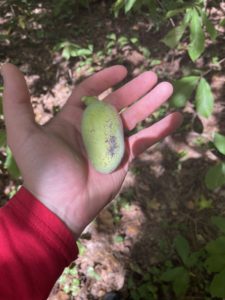
As we approach the end of summer, many Richmonders will enjoy foraging for a native fruit that’s abundant in town: The Pawpaw. Pawpaws are a native understory tree, typically found near bodies of water in well-drained soil. Here in Richmond, they’re commonly found along trails leading to the James River. For those that aren’t familiar with this fruit, here are a few tips to keep in mind if you plan on hitting the trail looking for this local delicacy.

Look up-
Most Pawpaw groves are full of hundreds of trees. Not all of them will have fruit, so begin your search by looking up into their canopies. Lightly shaking the trees can also help determine if they’re ripe. If the fruit comes loose, there’s a chance its ready.

Look down-
Fallen fruit is a sign that trees are beginning to ripen. Sometimes fallen fruit can be harvested, but I typically try and leave these for wildlife.
Use your nose-
When Pawpaws are ripe, the woods will have a distinct sweet and fruity aroma. This is a telltale sign that the fruit is ready.
Get a grip-
Ripe Pawpaws, just like any other fruit, needs to be fairly soft to be edible. And, just like other fruit, there is a fine line between ripe and over-ripe. Use your best judgment, but a general rule of thumb is to look for the firmness of a ripe mango.
A final note on foraging-
As with any type of wild food, always make sure you know what you’re looking for. Never consume anything you’re unsure of. Also, make sure that you don’t over-harvest an area. Always leave some for others, both human and animal!



